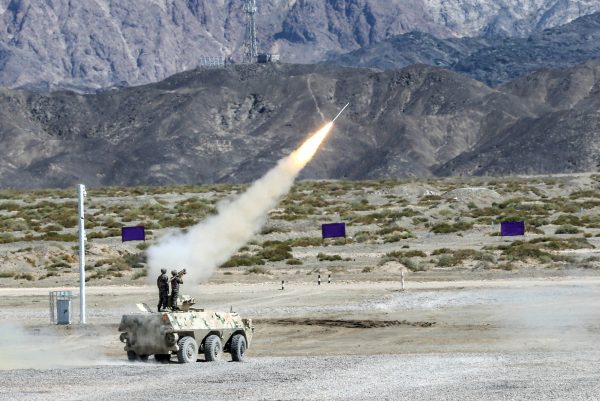The United States does not possess any ground-launched missiles with 500–5500-kilometre ranges due to INF Treaty limitations. But after it withdrew from the treaty in August 2019, US Defense Secretary Mark Esper said the United States would deploy ground-launched intermediate-range missiles in Asia ‘sooner rather than later’.
China’s missile developments may be changing military strategy in Asia.
For decades, China’s military planners have understood the strategic importance of long-range missiles and invested heavily in their development. The recent military parade unveiled the DF-41, a new multiple independently targetable re-entry vehicle-capable (MIRV-capable), road-mobile, solid-fuel intercontinental ballistic missile (ICBM) with an operational range of 12,000–15,000 kilometres. China calls the DF-41 the cornerstone of its strategic nuclear capability. Additionally, China tested a new submarine-launched ballistic missile (SLBM) JL-3 last December. China already deploys DF-5B MIRV-capable ICBMs and JL-2 SLBMs. Together with the DF-41, these nuclear-capable missiles compose China’s strategic deterrent capability.
Even with China’s deployment of a new missile it is difficult to overcome the overwhelming superiority of US nuclear armament. The United States deploys about 400 ICBMs to China’s 70, mutually deterring the nuclear threat.
But China’s GLCMs raise the stakes of a possible arms race between the United States and China in the Asia Pacific. During the 70th anniversary parade, China also unveiled the DF-17 and DF-100 GLCMs. The DF-17 is China’s first hypersonic glide vehicle (HGV) and the DF-100 is a supersonic weapon with a range of 1500 kilometres. Russia has also just entered their new ‘Avangard’ HGV into service.
Hypersonic weapon development is underway the world over. Compared with subsonic weapons, such as the Tomahawk missile, a hypersonic weapon has a reduced total flight time, increasing offensive capability. The proliferation of hypersonic weapons has the potential to destabilise and upset regional stability. US General John Hyten has said that there is no defence ‘that could deny the employment of such a weapon’.
China already deploys DF-21D medium-range ballistic missiles and DF-26 intermediate-range ballistic missiles. These two missiles were unveiled during a military parade in 2015. It is estimated that both are capable of attacking naval targets, including aircraft carriers. The DF-26 has a maximum range of 4000 kilometres and is known as the ‘Guam Killer’.
These ballistic missiles and GLCMs play a key role in China’s anti access/area denial strategy, in which China aims to build ‘sanctuary’ within the first or second island chains. This sanctuary has two purposes: to protect China’s nuclear submarines and to restrict the actions of US warships. While China doesn’t have a great number of anti-ship ballistic missiles it does possess enough to deter hostilities within the island chains.
Joseph Nye points out that fixed bases on Okinawa are also increasingly vulnerable because of China’s advanced ballistic missiles. These advanced weapons change US calculations in the potential use of force.
China has increased its missile capability by more than the United States in recent years, with the latter having little to show in effective proportionate countermeasure. China’s ballistic missiles and GLCMs are deployed from within China and protected. The current US missile defence system cannot intercept all missiles perfectly and cannot deny a ground-launched exercise from China.
After the United States withdrew from the INF Treaty it immediately tested a GLCM and a ground-launched ballistic missile. Additionally, the US Army is expecting the arrival of a long-range hypersonic weapon (LRHW) in 2023. The LRHW is a ground-launched hypersonic glide vehicle like the DF-17.
China has been critical of these developments, with Chinese Foreign Ministry spokesman Geng Shuang advising the United States to ‘abandon outdated notions of Cold War thinking and zero-sum games and exercise restraint in developing arms’.
Secretary Esper argues in favour of placing GLCMs in Asia. If the United States were to deploy a new type of missile in Asia, three candidate sites would be found in the US island of Guam and the US allies of Japan and South Korea. The two allies would undoubtedly feel knock-on effects from the new US plans. In the past, China has directly warned Japan and South Korea not to accept the deployment of US intermediate-range missiles. China imposing sanctions on South Korea in response to the 2017 Terminal High Altitude Area Defense deployment suggests that new US missiles would result in similar circumstances for both Japan and South Korea. South Korea has already said it does not have plans for these missiles on their soil, spelling trouble for any US effort in persuasion.
The United States is likely to maintain its nuclear superiority despite China’s improving capability. But China’s intermediate-range missiles do reach US assets in East Asia. These missiles are beginning to change the game — a longstanding power imbalance between the United States and China in Asia is now becoming one in which China’s second-strike capabilities offer Beijing much more security than it once had. The United States restarting its GLCM development is ample evidence of an unfolding balancing phenomenon.
The United States and China already are engaged in a trade war, and perhaps even a tech-war. Add to that a missile race and it’s clear the US–China struggle for power in Asia is escalating.
Tsuyoshi Minami is Postdoctoral Fellow at the College of Humanities and Communications, Shanghai Normal University.

